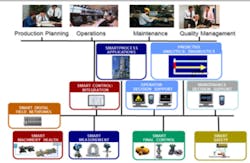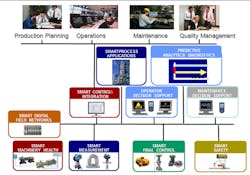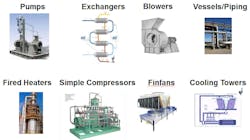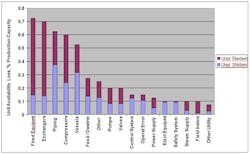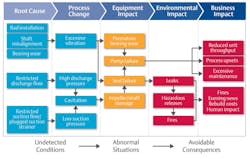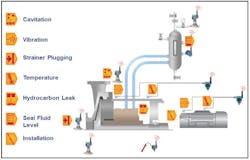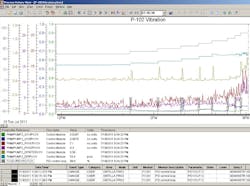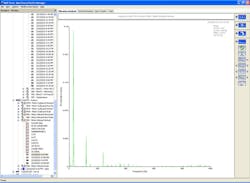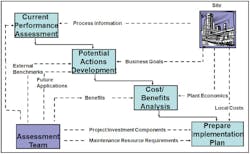In today’s global marketplace, companies are constantly working to improve margins and drive down costs. In the past, many companies installed older automation technologies, which were often proprietary in nature, to control their manufacturing plants and extend the life of their aging assets. Not surprisingly, few companies benefited beyond the limited functionality of those legacy technology-based products. In recent years, however, powerful and affordable smart technologies have revolutionized the field of computers and communications by redefining functionality, packaging, and price/performance. These innovations are also having a dramatic impact on sensor, automation, and information technologies. Successful companies have leveraged the knowledge and experience of leading automation companies in implementing smart plant projects to consistently deliver quantifiable business results measurable in real-time, predict asset performance, avoid surprises, and reduce risks to life, plant, and environment.
In recent years, however, powerful and affordable smart technologies have revolutionized the field of computers and communications by redefining functionality, packaging, and price/performance. These innovations are also having a dramatic impact on sensor, automation, and information technologies. Successful companies have leveraged the knowledge and experience of leading automation companies in implementing smart plant projects to consistently deliver quantifiable business results measurable in real-time, predict asset performance, avoid surprises, and reduce risks to life, plant, and environment.
My, My—How Things Have Changed
A key factor that has enabled the emergence of smart plants is the phenomenal advances in computer, communications, and packaging technology over the past 20-plus years. These advances are best exemplified in the functionality and price/performance characteristics of cell phones purchased in the 1990s versus the “smart phones” purchased today. Due to its bulky size, high cost, and limited voice-only functionality, market acceptance of the cell phone of the ’90s was limited to just a few individuals who could justify the cost. Today’s smart phones offer the performance and functionality of older mainframe computers, but at a fraction of the cost. The pocket-sized, ultra-compact packaging of smart phone technology, power of various apps, and its affordability has resulted in virtually everyone owning a smart phone today. In like fashion, intelligent applications are now available to make production facilities easier to operate and maintain. The smart plant is now possible with similar characteristics to a smart phone.
Figure 1 illustrates a smart plant architecture built with smart functional modules that are capable of standalone and/or a fully integrated operation. The foundation of a smart plant is built on smart field devices, such as multivariable transmitters, valves with intelligent positioners, pumps with built-in diagnostics, and others. These devices are configured to measure multiple variables at a high frequency, perform control actions based on the measured data, and analyze data from a historical time period to better predict a future operating state of the plant asset. Next, the smart plant is based on smart communications networks, which enable these smart field devices to communicate with one another. The smart networks may be automatically reconfigured to establish alternative communication paths in case of a failure or multiple failures on a path.
Finally, the smart plant architecture offers decision support tools, solutions, and interfaces (referred to as smart plant “apps” or functional modules). These apps are pre-engineered solutions that integrate measurement technology, process knowhow, and intricate knowledge of the plant assets to enable a user to make smart and proactive decisions based on predictive technology. The apps may be customized for plant personnel (e.g., for the operator, engineer, maintenance, quality control, or business office) to intuitively interact with plant assets and production systems.
Smart Plant vs. Legacy Digital Technologies
Legacy digital technology-based measurement and automation systems that were installed in plants over the past 20-plus years exhibited similar characteristics as the cell phones of the 1990s. They were bulky, expensive, and had limited functionality. As a result, measurement and control functionality was restricted (due to budget constraints) to important control loops that were necessary to operate the plant safely. Many other measurement and control functions were often handled manually and manual processes are often prone to errors.
The use of advanced process control (APC) technology, while promising significant operating improvements, was expensive, complex, and difficult to maintain in a plant environment. In many cases, the APC was simply turned off to eliminate headaches. In short, the plant staff was always operating in a reactive mode as it tried to respond to process events that had already occurred. The result was more frequent process upsets and unexpected plant shutdowns, costing millions of dollars in lost profits.
Smart plant technology empowers employees with smart tools to change the mode of operations from reactive to a predictive and proactive mode. In particular, wireless communication reduces the cost of measurement of plant conditions, often to only 25 percent of wired solutions. With more measurements available, users can now implement pre-engineered apps to continuously monitor and control a large percentage of plant assets. Depending on the asset being monitored, the app may include hardware, software, communications, and embedded engineering expertise that captures the knowledge of leading experts. The apps, which may be customized for operator, engineer, maintenance, quality, or business-oriented functions within a plant, provide a predictive decision-making tool that can be used to predict likely future outcomes for the asset. Table 1 summarizes advantages of smart plant technology compared to legacy digital technology.
‘What-If’ Scenarios In a Smart Plant
Many readers may have experienced an unforeseen process upset caused by a failure of a plant asset that quickly cascaded into other plant areas, causing a plant shutdown. Obviously, during such an upset everyone is looking for answers to determine why asset failure occurred and how to prevent it from happening again. When in this situation, one often asks questions like: “What could I have done differently to avoid a similar event?” or “What if I had smart apps in the plant that had forewarned me about an impending plant shutdown condition?” or “What timely actions could I have taken beforehand to potentially avoid a shutdown?” Planning and decision aids based on predictive technologies are now available to help prevent similar incidents in the future.
|
|||||||||||||||||||||
|
Table 1. Advantages of smart technology vs. legacy digital technology |
How to Achieve Plant Objectives of 4 Zeros with Smart Plants
Generalizing across many process industries, the four primary objectives for operating a plant are:
- Safety—The goal is to achieve zero serious safety incidents.
- Sustainability—The goal is zero incidents of environmental non-compliance, or excess energy use, or excess waste.
- Reliability/Availability—The goal is to achieve zero instances of unscheduled downtime.
- Financial Optimization—The goal is zero lost profit opportunities.
Smart plant technology is a key enabler in the pursuit of these goals by providing early detection of potential failures, providing predictive decision making tools, and enhanced safety systems. As will be illustrated with examples, smart plant technology may be used to predictively and proactively monitor the performance of various types of plant assets illustrated in Figure 2 and Table 2.
Obviously, being mechanical in nature, many assets may be prone to unexpected failures even if they are properly maintained. Figure 3 is a graph illustrating potential failure events and typical values for their relative impact on production. For example, the graph illustrates that the top three faults that have the most significant impact on availability were problems with piping, vessels, and compressors. Obviously, results from reader sites may show different frequencies. Smart apps used for monitoring plant assets may substantially reduce the impact of unexpected failures on plant safety, environment, and economic losses.
Reliability, Availability, Maintenance with Smart Plants
Since only a small percentage of plant assets were continuously monitored for safe operation of a plant with legacy systems, many assets that were “essential but not critical” were either monitored manually or only during scheduled maintenance—or in some cases not monitored for long periods of time. These infrequently monitored assets typically operated continuously until they failed unexpectedly. With an affordable smart plant technology solution, a much higher percentage of plant assets are monitored and this improves the operational certainty of the plant.
Maintaining plant assets using only manual repair schedules or waiting until they run-to-failure can be an expensive proposition. Unexpected downtime caused by asset failure negatively impacts plant throughput. In addition, planned downtime (such as scheduled maintenance shutdowns) for longer time periods or more frequent intervals than necessary may also decrease plant throughput. Most plants still rely on reactive or preventative maintenance practices even though these practices reduce the availability of plant assets. Smart plant solutions enable switching of maintenance practices from reactive to a predictive and proactive approach in which asset monitoring and diagnostic technologies predict the occurrence of developing problems. This switch can result in a 1–3 percent increase in potential plant production by reducing unexpected shutdowns without an increase in maintenance costs. In a predictive and proactive maintenance mode, service is performed only when it is needed. The advance warning enables plant staff to plan and schedule maintenance service in a flexible manner, e.g., delay repair until a planned shutdown occurs, but well before the predicted problem causes an asset malfunction.
Global companies like PDVSA and Petrobras have documented quantifiable business results by implementing smart plant apps to monitor plant assets. Specifically, predicted unexpected failures and associated downtime in one case resulted in a documented financial benefit of $70 million over two years. With a predictive maintenance approach, companies have been able to reduce costs compared to reactive and preventive maintenance. Another company, Rompetrol, documented benefits of $10.1 million/year increase in production throughput by using predictive diagnostics capability of smart plants.
Smart App for Monitoring a Pump Asset
Pumps are an essential plant asset for flow of fluid material. Pump failures in a typical refinery account for an estimated 0.2 percent loss in production, and pump-related repairs account for about 7 percent of the plant maintenance budget. Unexpected pump failures may contribute to process shutdowns, or even worse. In some cases they may lead to safety and environmental incidents. Typical root causes that often lead to pump failures may include cavitation, leaks due to seal or piping failure, excessive vibration, and others.
Figure 4 illustrates cause and effect diagram of pump failures. Pre-engineered apps for monitoring pumps can embed measurement, process and pump knowledge to monitor common pump failures and predict potential abnormal operation of the pump. Figure 5 illustrates typical measurements that may be collected to monitor the health of a pump. One example of applying process and pump knowledge is by utilizing historical trend data collected by the app to analyze asset health and performance. Figure 6 shows a historical trend graph of pump-related measurements, which is used to predict early conditions leading to cavitation, and Figure 7 shows a vibration frequency curve that can be obtained wirelessly to detect the cause of imbalance in a pump.
Similar to the smart app described above for pumps, Table 2 lists pre-engineered apps that are available to detect abnormal conditions in other plant assets.
Quantifiable Benefits of Smart Plant Apps in Energy Usage
By using a smart app for advanced process control on a crude unit, Rompetrol saved $1.8 million per year in energy costs. In a boiler application, fuel savings of 2–6 percent may be achieved by operating the boiler at minimum required air. In another smart app solution implemented at Galp Portugal for a crude unit, the operating constraints were pushed to the limits dynamically in real-time to optimize yield by 0.7 percent and improve profit by $2.6 million per year.
Challenges to Implement Smart Plant Projects
Any particular smart plant technology implementation project may be very successful for one company, but only marginally successful for another company. Why is there a difference? Company culture and adaptability to change may be two important “people” considerations for determining the benefits of new technology. If acceptability of the new technology by plant staff and/or perceived impact of the new technology on “people” and “functions” within a plant is not considered prior to implementation, then the project risks may be significantly higher. Use of training and simulation tools has been commonly used to alleviate fears of using the new technology.
A Methodology to Implement Smart Plants
How does one go about implementing smart plant projects? Is there a starting point? A smart plant architecture as described in Figure 1 need not be implemented as a top-down or bottom-up approach. A plant may initiate a smart plant project anywhere based on the highest priority needs of the business. Smart plant implementation methodology allows for an installation of a field network to monitor plant and process information, or installation of a plant network to improve tools for plant management. The smart plant architecture may be seamlessly and easily expanded to accommodate growing needs of the business.
As shown in Figure 8, the methodology to implement smart plant projects starts off with a targeted study conducted at the plant to asses current performance versus needs, prioritize implementation and develop an action plan, obtain accurate costs, firm up a project schedule, and outline deliverable benefits.
Many companies prefer to reduce project risks by leveraging the knowledge and experience of leading automation suppliers to complete similar projects, which pays off not only in achieving improved certainty in plant operations, but also adds to the bottom line. Working with vendors who have demonstrated experience with smart plants can both help to set expectations for results and help ensure positive returns on key initial projects.
|
||||||||||||||||
|
Table 2. Abnormal conditions in common plant assets. |
The Future
Just as each new release of smart phones brings exciting and often unexpected advances in functionality, advances in process manufacturing technology is bringing exciting new opportunities to bear on plant problems.
The continuing evolution in digital computing and communication capabilities and the application of these technologies has led to fundamental differences in the way process plants operate with improved certainty and will continue to change the way they will operate in the future.
Figure 8. Methodology for implementing smart plant projects
Doug White is the director of the Refining Industry Solutions Group in the Process Systems and Solutions Business Unit of Emerson Process Management and a Senior Principal Consultant. Previously he held senior management and technical positions with MDC Technology, Profitpoint Solutions, Aspen Technology, and Setpoint. In these positions he has been responsible for justifying, designing, developing and implementing state-of-the-art automation systems. He earned a bachelor’s degree in Chemical Engineering from the University of Florida, a master’s degree from California Institute of Technology, and a master’s and Ph.D. from Princeton University. He can be reached at [email protected].
